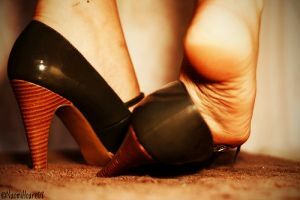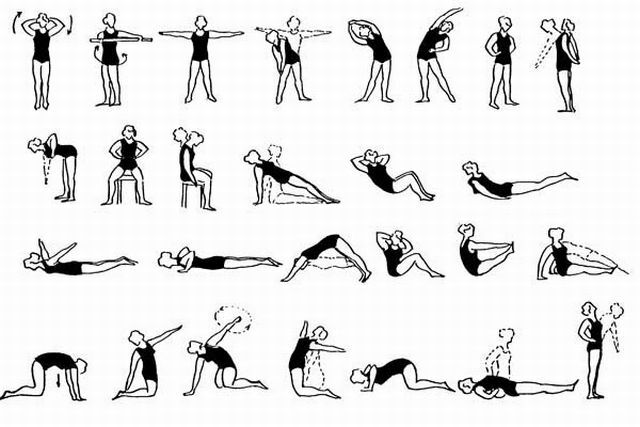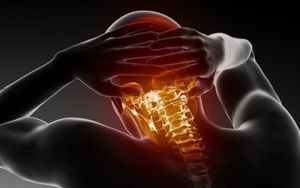 Almost every adult at least once faced with such an unpleasant phenomenon as pain in the cervical spine. This section of the spine consists of the vertebrae ( more fragile than in other departments), intervertebral discs and specifically arranged joints, which provide vital motor abilities.
Almost every adult at least once faced with such an unpleasant phenomenon as pain in the cervical spine. This section of the spine consists of the vertebrae ( more fragile than in other departments), intervertebral discs and specifically arranged joints, which provide vital motor abilities.
The neck performs a number of necessary functions - it protects the spinal canal, supports the head, and also provides its ability to turn in various directions and be fixed in a certain position.
Neck pain can be different - pulsating, pulling, piercing, pricking. As a rule, their intensity is enhanced even with minor movements or muscle tension. Often, such pains in the neck and occiput are accompanied by numbness of hands, darkening in the eyes, dizziness, noise in the ears.
By the nature of the localization is allocated:
- cervicalgia - a pain that is concentrated only in the neck;
- cervicocranyalgia - pain giving to the head;
- cervicobrahialgia is a pain that radiates into the hand.
The main causes of pain
- The main causes of pain
- Injury and ligament damage
- The presence of inflammatory-degenerative diseases
- Cramp spasms
- Systemic diseases
- Immune disorders
- How to relieve pain and stiffness of movements
- Video: The neurologist explains the causes of neck pains
The main reasonspain sensations
Usually neck pains are associated with with mechanical problems of in this area, but they can also indicate the presence of inflammatory processes, infections or oncological diseases .The following causes of neck pain can be identified:
Injuries and ligament damage to
Most often, the patient receives such injuries during road traffic accidents, or when doing sports or working. Also, such damage occurs when falling on the face in elderly people or in people with diseases that contribute to a decrease in bone density.
The most common are extensor injuries of the cervical department of .For such lesions, is characterized by the following symptoms of :
- muscle tension;
- increasing pain in the front of the neck;
- mobility impairment;
- the patient can not tilt his head to the side opposite to the damaged one.
Presence of inflammatory-degenerative diseases
Osteochondrosis is a disease of the spine, in which degeneration of the intervertebral disc and gradual ossification of the cartilaginous tissue occur. There are many reasons for the development of this disease - hereditary predisposition, age changes, trauma, and improper diet and sedentary lifestyle, frequent hypothermia, persistent physical activity, etc.

Neck pain caused by osteochondrosis
Osteochondrosis of the cervical spine causes pain in the neck, irradiating the head, shoulder or arm. The patient complains of flashing "flies" before his eyes, unbearable headaches of a pulsating nature and dizziness.
Complications of the osteochondrosis of the cervical region can be intervertebral hernia. With this disease, pain in the neck is most often mild, while other signs - numbness of the fingers of the upper limbs, pain in the shoulders are quite strong. Clinical picture is supplemented with a headache, changes in blood pressure, dizziness, pain in the scapula.
Pain in the cervical region can cause a disease such as spondylosis - a disease that is characterized by the growth of bony outgrowths along the edges of the vertebral bodies. This pathology develops due to osteochondrosis, various injuries, inflammation of the joints, as well as prolonged exertion. The main symptoms of are :
- neck mobility limitation;
- sensation of discomfort when turning the head ":
- strong pain in the occiput, as well as in the back of the head, shoulders, in the ears and eyes;
- crunching in the neck;
- numbness and tingling in the fingers;
- dizziness.
Cramps cramps
Occur due to sudden movements, which, creating excessive pressure in the cervical spine, disrupt blood circulation. Spasms can also occur as a result of a lack of nutrients in the body - calcium, sodium, magnesium, potassium, B vitamins. For this pathology , a characteristic sign is severe pain and edema in the neck , as well as sudden muscle contractions.
The presence of tumors - sarcomas, hemangiomas, osteoblastoklastomy
Tumors of the spine are very rare and, in most cases, specific reasons for their development can not be established. Among the risk factors for these diseases are heredity, the presence of spinal column injuries in history, chronic spine diseases and adverse environmental conditions. Characteristic symptoms of tumor processes :
- painful sensations, which increase with the growth of neoplasm. Such pains are very difficult and short-term stop drugs, do not pass in a state of rest, moreover - intensify at night and with sudden movements;
- reduced sensitivity;
- muscle weakness;
- is a disorder of the cerebral circulation, which is manifested by darkening in the eyes, noise in the ears, dizziness and fainting, headaches, nausea.
Systemic diseases
Pains that arise in the neck and give to the scapula or sternum and are accompanied by shortness of breath, arrhythmia, increased blood pressure may indicate myocardial infarction .
For various injuries of the ribs and chest, as well as tuberculosis, bronchial asthma, pneumonia, cystic fibrosis, lung tumors, pneumothorax may develop( air entering the pleura), which can also be indicated by pain in the neck and in the region of the shoulder blades.
Pain in the cervical spine and difficulties in tilting and turning the head causes such diseases as meningitis, occipital abscess, lymphadenitis, shingles, Bekhterev's disease.
Immune disorders
One of these diseases is rheumatoid arthritis , which affects the vertebral joints of the cervical region. At the same time, painful sensations are accompanied by a restriction of mobility of the neck and stiffness in this area.
Rheumatic polymyalgia may be threatened by in people of advanced age, where pain in the neck and stiffness of the shoulder zone are very rapid.
However, not always pain in the cervical spine indicates the presence of any serious disease. Very often, they are caused by a prolonged static position or excessive load, as well as hypothermia or a banal draft.
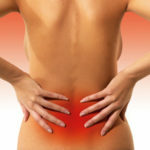 Are you worried about aching back pain? Learn more about the causes of lumbar pain from our article.
Are you worried about aching back pain? Learn more about the causes of lumbar pain from our article. Severe pain in the shoulder joint can cause serious abnormalities in the body. To find out about the consequences of an untimely visit to a doctor, click here.
How to relieve the pain and stiffness of movements
As mentioned above, prolonged exposure in one position, as well as excessive loads, lead to impaired blood circulation in the cervical spine and, as a result, the development of pain. Everyday gymnastics is the best prevention for the cervical spine. As for prophylactic and neck pain, it is recommended that the following exercises be performed regularly by :
- sit on a chair or on the floor with legs crossed. Try to maximally involve the stomach and straighten the lower back, stretch the crown to the ceiling, that is, straighten the cervical section. Make a slow exhalation and slightly tilt your head forward, then slowly exhale and return to the starting position. This exercise well helps to remove the compression of vertebral discs and pinching of the nerve roots;
- the starting position is the same. Slowly and very smoothly turn his head in one direction, try to look over his shoulder and stand for a couple of seconds in this position. Just slowly turn your head back. Repeat for the other side. The purpose of this exercise is to improve the mobility of the cervical vertebrae;
- the starting position is the same. Pull the head as far as possible forward, the chin should be parallel to the floor. Then push the head back with the back to the stop.
For , the doctor can prescribe the use of non-steroidal anti-inflammatory drugs, analgesics, muscle relaxants and sedatives. In severe pain, steroids are injected.
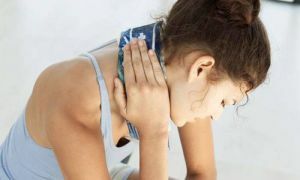 Effective can be rubbing various warming balms and ointments , and in some cases - application of cold compresses .Such lotions and compresses can be prepared on the basis of medicinal plants - elder, nettle, mother-and-stepmother, chamomile, horsetail.
Effective can be rubbing various warming balms and ointments , and in some cases - application of cold compresses .Such lotions and compresses can be prepared on the basis of medicinal plants - elder, nettle, mother-and-stepmother, chamomile, horsetail.
The complex therapy should also include physiotherapy and manual therapy - massage, hirudotherapy, acupuncture, vacuum therapy .
The application of these methods will help to effectively remove the inflammatory process, activate blood circulation and maximally relax the muscles.
In case of pain in the cervical spine, you should seek help from the doctors of the following specialties:
- therapist;
- neurologist;
- traumatologist;
- cardiologist;
- ENT.

